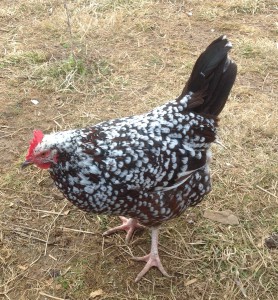The Joy of Raising Chickens
The first egg of the season came as a surprise. In sync with the shorter days of winter, our chickens tend to “lay off” for a while. I wasn’t expecting (eggspecting?) any eggs until late January or so. Yet there, on the 15th of December, tucked into the straw of the nesting box, was a small blue-shelled egg. I was reminded once again of the joy of raising chickens.
We’ve kept a small flock of chickens for several years now. We have Buff Orpingtons, Black Australorps, Speckled Sussex, and Americuana, among a few other breeds. The Buffies are the color of a new penny. The Australorps are black iridescence. The Specs, my favorites for their personable nature, are, as you might guess, speckled. Americuanas, the layers of the blue-shelled eggs, come in various colorations, and with their hooded heads, are reminiscent of hawks.
Chickens are a model of sustainability. They exist largely on kitchen scraps and foraged insects and seeds, and, in turn, supply healthy food in the form of eggs and meat. They produce soil-enriching manure to support the growth of additional healthy food from your garden. Turn them loose in that garden and they will happily control damaging insects like squash bugs and cabbage worms (though be forewarned that they have been known to peck a hole in a ripe tomato here and there). When confined to a specific area for a period of time, chickens become living garden tillers, churning up the soil, and eating weed seeds—all the while depositing fertilizer in preparation for planting.
Our flock began as a box of wide-eyed, chirping peeps arriving through the mail. Starting with chicks is a fun, though moderately labor-intensive, way to get started in chicken rearing. From chick to egg layer may take up to six months depending on breed and environmental conditions. If you’re looking for a jumpstart to the process, buy pullets—think teenage chickens—which require less initial care and are closer to laying age. Once production begins, chickens lay for several years, with an average daily harvest of two eggs for every three members your flock.
The quality of eggs from homestead birds far exceeds that of the store-bought variety. Whereas eggs on the grocery store shelves may be weeks old, eggs from your own flock can go from nest to table in mere minutes. There’s no comparison when it comes to taste. You know from the moment you crack these eggs that they offer superior nutritional value—the egg yolks are luminous. (See sidebar for a nutritional analysis.)
Basic requirements for keeping chickens include a shelter of some sort, a safe pasture area in which to forage, a supply of clean water, and some grain to supplement their diet. In our case, we have three fenced pasture areas leading off from a central chicken coop. We simply rotate the chickens from one pasture to the next every few weeks to ensure fresh forage. Though we have fox and raccoons in the neighborhood, these wild predators have not been a problem thanks to our two large dogs patrolling the property. One of our dogs, however, hasn’t grasped that he is a protector and not himself a chicken predator—thus the fenced pastures. We’d prefer to let our chickens free-range, but our rotational grazing system works well enough.
For “townies” considering raising chickens on smaller lots, a chicken tractor is the perfect solution. Chicken tractors are small, moveable coops with attached, enclosed pasture areas that simply get wheeled around the yard. You’ll find a fun gallery of chicken tractors at http://thecitychicken.com/tractors.html.
Keeping chickens offers a certain attunement to the natural flow of things. Our old rooster assured that we were always well aware of the sunrise each morning. The chickens put themselves to bed at dusk, now getting noticeably later as spring comes on. The make-up of the scraps we feed them shifts with the turning seasons: grains, winter into spring; greens, spring into summer; and the full garden’s bounty, summer through autumn. There’s something about the daily ritual of gathering eggs that keeps us connected to nature’s rhythm. And a freshly laid egg, still warm in your hand, is one of life’s simple joys.
Jeff Feldman is a speaker, writer, and consultant on green living and green building. Reach Jeff at GreenPathConsulting@gmail.com.
Homegrown Eggs Are More Nutritious
The 2007 Mother Earth News egg-testing project concluded that eggs from pastured chickens, compared to official USDA nutrient data for commercial eggs, may contain:
- 1/3 less cholesterol
- 1/4 less saturated fat
- 2/3 more vitamin A
- twice the omega-3 fatty acids
- three times more vitamin E
- seven times more beta carotene
- four to six times more vitamin D








